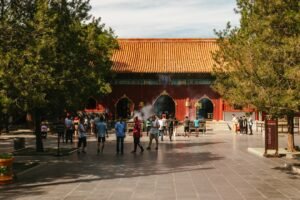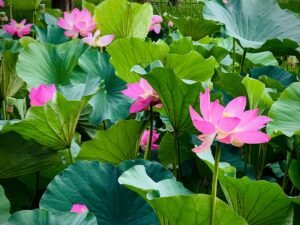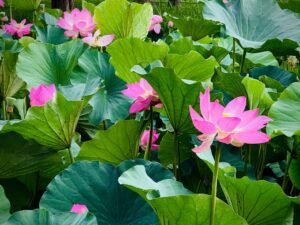

Mastering the Superlative with ‘最’ (zuì)
The superlative form is a linguistic construct that allows speakers to express the highest degree of a quality among three or more entities. In English, we often use the suffix “-est” or the word “most” to convey this meaning. For instance, when we say “the tallest building” or “the most beautiful painting,” we are indicating that these subjects possess the utmost degree of the qualities being described.
This grammatical feature is essential for making comparisons and highlighting distinctions in various contexts, whether in casual conversation or formal writing. In Chinese, the concept of superlatives is similarly significant, but it is expressed through different linguistic mechanisms. One of the most common ways to convey superlatives in Mandarin is through the use of the word “最” (zuì), which translates to “most” or “the most.” Understanding how to effectively utilise this term is crucial for anyone looking to master the nuances of the Chinese language.
By grasping the superlative form, learners can enhance their descriptive capabilities and engage in more sophisticated conversations. Ready to speak Chinese? Enroll for Chinese classes at the NLS Norwegian Language School in Oslo!
Table of Contents
ToggleSummary
- The superlative form is used to compare three or more items and express the highest degree of a quality or characteristic.
- ‘最’ is used in Chinese to express superlatives and is placed before the adjective or adverb to indicate the highest degree.
- When comparing adjectives and adverbs with ‘最’, the structure is ‘最 + adjective/adverb + 的 + noun’ to form a superlative sentence.
- Mastering ‘最’ in different contexts involves understanding how to use it with different parts of speech and in various sentence structures.
- Common mistakes when using ‘最’ include incorrect placement, misuse of the structure, and confusion with other comparative forms.
Using ‘最’ to Express Superlatives
The character “最” serves as a pivotal tool in expressing superlatives in Mandarin Chinese. It is typically placed before an adjective or adverb to indicate that something possesses the highest degree of a particular quality. For example, if one wishes to say “the best teacher,” they would say “最好的老师” (zuì hǎo de lǎoshī).
This construction not only conveys the idea of superiority but also adds a layer of emphasis that enriches the statement. Moreover, “最” can be employed in various contexts, making it a versatile component of the language. Whether discussing personal preferences, academic achievements, or even culinary delights, “最” allows speakers to articulate their thoughts with clarity and precision.
For instance, one might say “我最喜欢的食物是寿司” (wǒ zuì xǐhuān de shíwù shì shòusī), meaning “my favourite food is sushi.” This usage illustrates how “最” can effectively highlight personal tastes and preferences.
Comparing Adjectives and Adverbs with ‘最’

When utilising “最” in comparisons, it is essential to understand how it interacts with both adjectives and adverbs. Adjectives describe nouns, while adverbs modify verbs, adjectives, or other adverbs. In Mandarin, “最” can be seamlessly integrated into both categories to express superlative forms.
For example, when comparing heights, one might say “他是最高的学生” (tā shì zuì gāo de xuéshēng), meaning “he is the tallest student.” Here, “最高的” (zuì gāo de) serves as a superlative adjective. In terms of adverbs, consider the sentence “她跑得最快” (tā pǎo de zuì kuài), which translates to “she runs the fastest.” In this case, “最快” (zuì kuài) functions as a superlative adverb, indicating that her speed surpasses that of others. This flexibility in using “最” with both adjectives and adverbs allows for a richer expression of comparisons and enhances one’s ability to convey nuanced meanings in conversation.
Mastering ‘最’ in Different Contexts
To truly master the use of “最,” learners must practice applying it across various contexts. The versatility of this term means it can be used in everyday conversations, academic discussions, and even in literary works. For instance, when discussing travel experiences, one might say “这是我去过的最美的地方” (zhè shì wǒ qù guò de zuì měi de dìfāng), meaning “this is the most beautiful place I have ever been.” Such expressions not only demonstrate linguistic proficiency but also allow for deeper engagement with cultural experiences.
Additionally, understanding the context in which “最” is used can significantly impact its effectiveness. In formal settings, such as presentations or written reports, employing “最” can lend authority to one’s statements. Conversely, in casual conversations among friends, it can add a playful tone.
For example, saying “他是我见过的最搞笑的人” (tā shì wǒ jiàn guò de zuì gǎoxiào de rén) translates to “he is the funniest person I have ever met,” showcasing how context shapes the delivery and reception of superlative expressions.
Common Mistakes When Using ‘最’
Despite its straightforward application, learners often encounter pitfalls when using “最.” One common mistake is misplacing “最” within a sentence. It should always precede the adjective or adverb it modifies; otherwise, the intended meaning may become unclear. For instance, saying “老师最好的” (lǎoshī zuì hǎo de) instead of “最好的老师” (zuì hǎo de lǎoshī) can lead to confusion and misinterpretation.
Another frequent error involves overusing “最” in contexts where it may not be necessary. While it is tempting to emphasise every quality with a superlative form, moderation is key. For example, saying “这是我最喜欢的最好的书” (zhè shì wǒ zuì xǐhuān de zuì hǎo de shū) translates to “this is my most favourite best book,” which sounds redundant and awkward.
Instead, one should opt for a more concise expression like “这是我最喜欢的书” (zhè shì wǒ zuì xǐhuān de shū), meaning “this is my favourite book.”
Polishing Your Superlative Sentences with ‘最’

To enhance one’s proficiency with superlatives using “最,” it is beneficial to engage in exercises that focus on sentence construction and variation. Practising different sentence structures can help learners become more comfortable with using “最” effectively. For instance, instead of simply stating “他是最聪明的学生” (tā shì zuì cōngmíng de xuéshēng), which means “he is the smartest student,” one could elaborate by adding context: “在班上,他是最聪明的学生,常常帮助其他同学” (zài bān shàng, tā shì zuì cōngmíng de xuéshēng, chángcháng bāngzhù qítā tóngxué), translating to “in class, he is the smartest student and often helps other classmates.” Additionally, incorporating synonyms and varying sentence lengths can add depth to one’s writing and speaking.
Instead of relying solely on “最,” learners can explore alternative expressions that convey similar meanings while still maintaining clarity. For example, using phrases like “无与伦比的” (wú yǔ lún bǐ de), meaning “unparalleled,” can elevate one’s language skills and provide a richer vocabulary for expressing superlatives.
Using ‘最’ with Different Parts of Speech
The character “最” can be effectively combined with various parts of speech beyond just adjectives and adverbs. For instance, when used with nouns, it can create phrases that denote a superlative quality associated with that noun. An example would be “这是我见过的最好的电影” (zhè shì wǒ jiàn guò de zuì hǎo de diànyǐng), meaning “this is the best movie I have ever seen.” Here, “最好” (zuì hǎo) modifies the noun “电影” (diànyǐng), showcasing how “最” can enhance noun phrases.
Furthermore, learners can experiment with using “最” in conjunction with verbs to express actions at their highest degree. For example, one might say “他唱得最好” (tā chàng de zuì hǎo), which translates to “he sings the best.” This construction highlights not only the action but also elevates it to a superlative level. By exploring these diverse applications of “最,” learners can develop a more comprehensive understanding of its role within the language.
Expressing Superlatives in Conversational Chinese with ‘最’
In conversational Chinese, employing superlatives using “最” can significantly enhance one’s ability to communicate effectively and expressively. When engaging in discussions about preferences or opinions, incorporating superlatives allows speakers to convey their feelings more vividly. For instance, during a conversation about favourite foods, one might say, “我觉得披萨是最好吃的食物” (wǒ juédé pīsà shì zuì hǎo chī de shíwù), meaning “I think pizza is the most delicious food.” This not only expresses a personal preference but also invites further dialogue on culinary experiences.
Moreover, using superlatives can help establish rapport and connection with conversational partners. When sharing opinions about movies or music, saying something like “这首歌是我听过的最好听的歌” (zhè shǒu gē shì wǒ tīng guò de zuì hǎo tīng de gē) translates to “this song is the best song I have ever heard.” Such expressions create opportunities for shared interests and discussions about cultural tastes, fostering a more engaging conversational atmosphere.
Using ‘最’ in Written Chinese
In written Chinese, employing superlatives with “最” adds clarity and emphasis to one’s arguments or narratives. Whether crafting essays, reports, or creative writing pieces, integrating superlatives can enhance the overall impact of the text. For example, when writing an article about travel destinations, one might state, “这个城市是中国最受欢迎的旅游胜地之一” (zhège chéngshì shì zhōngguó zuì shòu huānyíng de lǚyóu shèngdì zhī yī), meaning “this city is one of the most popular tourist destinations in China.” Such statements not only inform readers but also evoke interest and curiosity.
Additionally, using superlatives effectively in written Chinese requires attention to style and tone. In formal writing contexts, it is essential to maintain a level of professionalism while still conveying enthusiasm or admiration through superlative expressions. Conversely, in creative writing or personal narratives, one may adopt a more casual tone while still utilising superlatives to evoke emotion and connection with readers.
Exploring Advanced Superlative Structures with ‘最’
As learners progress in their understanding of Mandarin Chinese, they may wish to explore more advanced structures involving superlatives with “最.” One such structure involves combining multiple adjectives or adverbs to create complex superlative phrases. For instance, one could say “她是我见过的最聪明、最有才华的人” (tā shì wǒ jiàn guò de zuì cōngmíng, zuì yǒu cáihuá de rén), translating to “she is the smartest and most talented person I have ever met.” This construction not only emphasises multiple qualities but also showcases linguistic sophistication. Another advanced structure involves using comparative phrases alongside superlatives for added depth.
For example: “在所有的学生中,他是学习成绩最好的” (zài suǒyǒu de xuéshēng zhōng, tā shì xuéxí chéngjī zuì hǎo de), meaning “among all the students, he has the best academic performance.” Such constructions allow for nuanced comparisons and enrich one’s ability to articulate complex ideas effectively.
Practice Exercises to Perfect Your Use of ‘最’
To solidify one’s understanding and application of superlatives using “最,” engaging in practice exercises can be immensely beneficial. One effective exercise involves creating sentences that incorporate various adjectives and adverbs alongside “最.” For instance, learners could be prompted to write sentences such as “这本书是我读过的最好的一本书” (zhè běn shū shì wǒ dú guò de zuì hǎo de yī běn shū), meaning “this book is the best book I have ever read.” This exercise encourages creativity while reinforcing grammatical structures. Additionally, learners could benefit from peer review sessions where they exchange sentences and provide feedback on each other’s use of superlatives with “最.” This collaborative approach fosters a supportive learning environment while allowing individuals to refine their skills through constructive criticism.
By consistently practising and applying these exercises in both spoken and written contexts, learners will undoubtedly enhance their command of superlatives in Mandarin Chinese. In conclusion, mastering the use of ‘最’ for expressing superlatives is an essential aspect of learning Mandarin Chinese. The character serves as a versatile tool that enriches both spoken and written communication across various contexts.
As learners continue their journey through the intricacies of the language at institutions like NLS Norwegian Language School in Oslo—where dedicated courses on Chinese are offered—they will find ample opportunities to refine their skills further. The school’s comprehensive curriculum not only focuses on grammar but also immerses students in cultural nuances that enhance their understanding of how to use ‘最’ effectively in everyday conversations and formal writing alike. By embracing these lessons and engaging actively with peers and instructors alike at NLS Norwegian Language School, students will undoubtedly gain confidence in their ability to express superlatives fluently and accurately in Mandarin Chinese.
Ready to speak Chinese? Enroll for Chinese classes at the NLS Norwegian Language School in Oslo!
If you want to learn Norwegian, you can register for classes here. We look forward to hearing from you and helping you become fluent in Norwegian.





